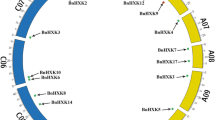Abstract
We have cloned a WD-repeat gene from peach. The cloned gene is more than 3 kb and contains signature domains characteristic of WD-repeat genes. Because of its high homology with AtTTG1, we hypothesized that this gene could be a TTG1 ortholog in peach. Functional studies were carried out by complementing the trichome minus Arabidopsis ttg1-1 mutant with the putative peach TTG1 homolog. Successful restoration of normal trichomes was achieved in the resulting transgenics. We further tested the possibility that this gene was the candidate gene differentiating peach and nectarine. Sequence analysis indicated no difference in the full-length TTG1 and 1,600 bp of its promoter between peach and nectarine.



Similar content being viewed by others
References
Bielenberg D. G.; Wang Y.; Fan S.; Reighard G. L.; Scorza R.; Abbott A. G. A deletion affecting several gene candidates is present in the Evergrowing peach mutant. J. Hered. 95: 436–444; 2004.
Brueggemann J.; Weisshaar B.; Sagasser M. A WD40-repeat gene from Malus x domestica is a functional homologue of Arabidopsis thaliana TRANSPARENT TESTA GLABRA1. Plant Cell Reports 29(3): 285–294; 2010.
Carey C. C.; Strahle J. T.; Selinger D. A.; Chandler V. L. Mutations in the pale aleurone color1 regulatory gene of the Zea mays anthocyanin pathway have distinct phenotypes relative to the functionally similar TRANSPARENT TESTA GLABRA1 gene in Arabidopsis thaliana. Plant Cell 16: 450–464; 2004.
Clough S. J.; Bent A. F. Floral dip: a simplified method for Agrobacterium-mediated transformation of Arabidopsis thaliana. Plant J. 16: 735–743; 1998.
Cokol M.; Nair R.; Rost B. Finding nuclear localization signals. EMBO Rep. 1(5): 411–415; 2000.
Daraselia N. D.; Tarchevskaya S.; Narita J. O. The promoter for tomato 3-hydroxy-3-methylglutaryl coenzyme A reductase gene 2 has unusual regulatory elements that direct high-level expression. Plant Physiol. 112(2): 727–733; 1996.
Gasic K.; Hernandez A.; Korban S. S. RNA extraction from different apple tissues rich in polyphenols and polysaccharides for cDNA library construction. Plant Molecular Biology Reporter 22: 437–438; 2004.
Guan X. Y.; Li Q. J.; Shan C. M.; Wang S.; Mao Y. B.; Wang L. J.; Chen X. Y. The HD-Zip IV gene GaHOX1 from cotton is a functional homolog of the Arabidopsis GLABRA2. Physiol. Plant. 134: 174–182; 2008.
Hiller M.; Platzer M. Widespread and subtle: alternative splicing at short-distance tandem sites. Trends in Genetics 24: 246–255; 2008.
Humphries J. A.; Walker A. R.; Timmis J. N.; Orford S. J. Two WD-repeat genes from cotton are functional homologs of the Arabidopsis thaliana TRANSPARENT TESTA GLABRA1 (TTG1) gene. Plant Molecular Biology 57: 67–81; 2005.
Ishida T.; Hattori S.; Sano R.; Inoue K.; Shirano Y.; Hayashi H.; Shibata D.; Kato S. T.; Tabata S.; Okada K.; Wada T. Arabidopsis Transparent Testa Glabra2 is directly regulated by R2R3 MYB transcription factors and is involved in regulation of GLABRA2 transcription in epidermal differentiation. Plant Cell 19: 2531–2543; 2007.
Kieleczawa J. Fundamentals of sequencing of difficult templates: an overview. J. Biomol. Tech. 17: 207–217; 2006.
Lescot M.; Dehais P.; Thijs G.; Marchal K.; Moreau Y.; Van de Peer Y.; Rouze P.; Rombauts S. PlantCARE, a database of plant cis-acting regulatory elements and a portal to tools for in silico analysis of promoter sequences. Nucleic Acids Research 30: 325–327; 2002.
Lodish H.; Berk A.; Matsudaira P.; Kaiser C. A.; Krieger M.; Scott M. P.; Zipursky S. L.; Darnell J. Molecular cell biology. 5th ed. Freeman & Co, New York; 2004.
Murashige T.; Skoog F. A revised medium for rapid growth and bioassays with tobacco tissue cultures. Physiol. Plant. 15(3): 473–497; 1962.
Payne C. T.; Zhang F.; Lloyd A. M. GL3 encodes a bHLH protein that regulates trichome development in Arabidopsis through interaction with GL1 and TTG1. Genetics 156: 1349–1362; 2000.
Pérez-Clemente R. M.; Pérez-Sanjuán A.; García-Férriz L.; Beltrán J.; Canas L. A. Transgenic peach plants (Prunus persica L.) produced by genetic transformation of embryo sections using the green fluorescent protein (GFP) as an in vivo marker. Mol. Breed. 14(4): 419–427; 2005.
Schellmann S.; Hulskamp M. Epidermal differentiation: Trichomes in Arabidopsis as a model system. Int. J. Dev. Biol. 49: 579–584; 2005.
Schellmann S.; Hulskamp M.; Uhrig J. Epidermal pattern formation in the root and shoot of Arabidopsis. Biochem. Soc. Trans. 35: 146–148; 2007.
Smith T. F. Diversity of WD-repeat proteins. Subcell. Biochem. 48: 20–30; 2008.
Walker A. R.; Davison P. A.; Bolognesi-Winfield A. C.; James C. M.; Srinivasan N.; Blundell T. L.; Esch J. J.; Marks M. D.; Gray J. C. The TRANSPARENT TESTA GLABRA1 locus, which regulates trichome differentiation and anthocyanin biosynthesis in Arabidopsis, encodes a WD40 repeat protein. The Plant Cell 11: 1337–1350; 1999.
Weigel D.; Glazebrook J. Transformation of Agrobacterium using the freeze-thaw method. Cold Spring Harbor Protocols. doi:10.1101/pdb.prot4666; 2006.
Wen I. C.; Sherman W. B.; Koch K. E. Heritable pleiotropic effects of the nectarine mutant from peach. J. Am. Soc. Hortic. Sci. 120: 721–725; 1995.
Yu L.; Gaitatzes C. G.; Neer E. J.; Smith T. F. Thirty-plus functional families from a single motif. Protein Science 9: 2470–2476; 2000.
Zhang F.; Gonzalez A.; Zhao M.; Payne C. T.; Lloyd A. A network of redundant bHLH proteins functions in all TTG1-dependent pathways of Arabidopsis. Development 130: 4859–4869; 2003.
Zhao M. F.; Morohashi K.; Morohashi K.; Hatlestad G.; Grotewold E.; Lloyd A. The TTG1-bHLH-MYB complex controls trichome cell fate and patterning through direct targeting of regulatory loci. Development 135: 1991–1999; 2008.
Acknowledgments
We acknowledge Dr. Alan Lloyd, Texas A&M University, who kindly provided the Arabidopsis ttg1-1 mutant seeds. In addition, we would like to acknowledge the Iranian Ministry of Higher Education (AT), CFI, OIT, OMAFRA, and OTFMB (SJ) for the financial support of this research.
Author information
Authors and Affiliations
Corresponding author
Additional information
Editor: J. Finer
Rights and permissions
About this article
Cite this article
Taheri, A., Jayasankar, S., Cline, J.A. et al. A WD-repeat gene from peach (Prunus persica L.) is a functional ortholog of Arabidopsis thaliana TRANSPARENT TESTA GLABRA1 . In Vitro Cell.Dev.Biol.-Plant 48, 23–29 (2012). https://doi.org/10.1007/s11627-011-9390-3
Received:
Accepted:
Published:
Issue Date:
DOI: https://doi.org/10.1007/s11627-011-9390-3




